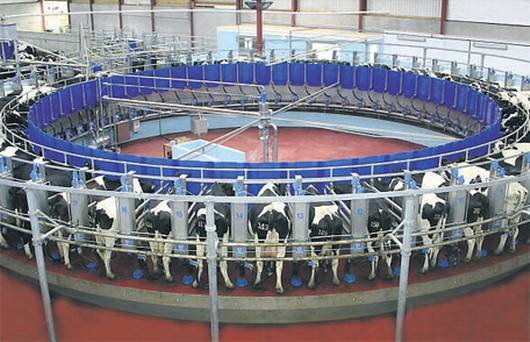
(Keeping the manufacturing of the equipment necessary to the automation of agriculture in the U.S. will be an important aspect of building the economy here. AltRightTV.com)
Lisa Baertlein & P.J. Huffstutter, Reuters
Convincing big U.S. dairy owners to buy robots to milk their cows — and reduce the farmhands they employ — used to be a tough sell for Steve Fried. Recently, his job has gotten easier, he says, in part because of President Donald Trump.
{snip}
Trump’s crackdown on illegal immigration through stepped-up arrests and border enforcement has shaken the U.S. agricultural sector, where as many as 7 in 10 farm workers are undocumented, according to the American Farm Bureau Federation.
In addition, Republican lawmakers in Congress have introduced legislation that would require all employers to check social security numbers against federal databases to ensure their workers are in the country legally, something that is now voluntary in all but a handful of states.
{snip}
The shift comes as the industry was already struggling to cope with a shrinking, aging workforce. That is ratcheting up pressure on the sector to embrace new technology.
Farmers and food companies increasingly are moving to automate dairy operations, chicken processing, crop production and harvesting. Even delicate crops such as strawberries and peaches are being considered for mechanization.
{snip}
A 2014 report by WinterGreen Research forecast significant growth in the use of robotics in “every aspect of farming, milking, food production” and other agricultural enterprises. The report put the market for agricultural robots at $817 million in 2013 and projected that it would reach $16.3 billion by 2020.
Sensing opportunity, investors are stepping up to address agriculture’s labor squeeze with new automation, helped by falling electronics costs and advancements in software, robotics and artificial intelligence.
Google Ventures, the venture capital arm of Alphabet Inc (GOOGL.O), this year spearheaded a $10 million investment in Abundant Robotics, which is working on an apple-picking robot. It also participated in a $20 million funding round for Bowery Farming, which uses robotics to grow leafy greens indoors.
Elsewhere, farm machinery maker Deere & Co (DE.N) announced that it spent $305 million to buy precision weed-killing robot maker Blue River Technology.
{snip}
The number of people caught trying to enter the United States illegally from Mexico dropped almost 60 percent between February and May compared the same period last year, according to government figures. Between late January to early September, the number of individuals arrested in the interior of the country by U.S. Immigration and Customs Enforcement (ICE) rose almost 43 percent over the same period in 2016.
{snip}
Bruce Taylor, CEO of Taylor Farms, a Salinas, California producer of salads and chopped vegetables for stores and restaurants, says his company has automated 20 percent of its packing plant.
The company has also teamed with an equipment maker to build a mechanized romaine harvester that is currently in use, and it is exploring automation for iceberg lettuce, broccoli and other field crops, Taylor said.
RISING PAY
In the meantime, farmers are raising wages. Data from the U.S. Department of Agriculture’s most recent farm labor report shows average wages during the week of April 9 to 15 were $13.23 per hour, up 4 percent from the same week a year ago.
“The mantra in agriculture right now is automate what you can and pay well for the labor you absolutely have to have,” said Paul Pittman, CEO of Farmland Partners Inc, (FPI.N) a real estate investment trust that invests in North American farm land.
To win the loyalty of its full-time production workers, garlic grower Christopher Ranch decided to raise pay by 50 percent between 2016 and 2018, getting a four-year jump on California’s mandated $15 minimum wage that will take effect in 2022.
{snip}